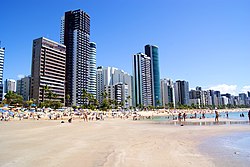Northeast Region, Brazil
region of Brazil, composed of nine states From Wikipedia, the free encyclopedia
Remove ads
The Northeast Region of Brazil (Portuguese: Região Nordeste do Brasil) is one of the five geographical regions of Brazil defined by the Brazilian Institute of Geography and Statistics in 1969. It is the third largest region, corresponding to 18% of the national territory, and the second in population.
Remove ads
Remove ads
Geography
The Northeast Region has an area of 1,554,291.31 km2 (600,115.23 sq mi). It is the region of the country with the longest coastline.
The climate in the region is very hot all the year long; tropical near the coast and semi-arid in the interior; semi-equatorial in the far west of the region. The vegetation mainly desert-like, with tropical forests along the coast and in the west and savanna-like vegetation, known as the Cerrado. in the southwest.
The Northeast Region is between 01° 02' 30" of latitude north and 18° 20' 07" of latitude south and between 34° 47' 30" and 48° 45' 24" of longitude west. It borders to the north and east with the Atlantic Ocean; to the south with the Minas Gerais and Espírito Santo states; and to west with the Pará, Tocantins and Goiás states.
The main rivers in the region are the São Francisco and the Parnaíba rivers; they have many tributaries.
Mountains
The highest point in the Northeast Region is Pico do Barbado (13°17′47″S 41°54′28″W) at 2,033 m (6,670 ft). Pico do Barbado is the highest summit of the larger Serra do Barbado, in the Chapada Diamantina, in Bahia.[1]
The highest point of the different states of the North Region are:[2]
Remove ads
States
This region is formed of nine states: Alagoas, Bahia, Ceará, Maranhão, Paraíba, Pernambuco, Piauí, Rio Grande do Norte and Sergipe.
Remove ads
Population
As of 1 July 2016[update], the Northeast region had a population of 56,915,936,[3] for a population density of 36.6 inhabitants/km2.
The most important municipalities of the North Region are:
- Salvador
- Fortaleza
- Recife
- São Luís
References
Wikiwand - on
Seamless Wikipedia browsing. On steroids.
Remove ads





